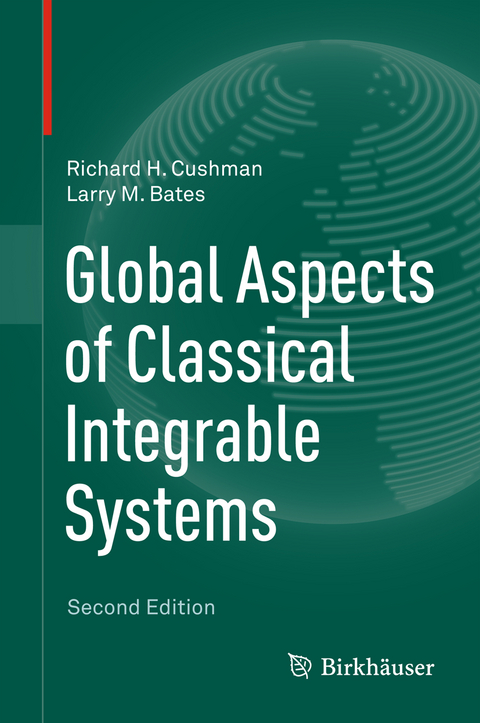
Global Aspects of Classical Integrable Systems
Springer Basel (Verlag)
978-3-0348-0917-7 (ISBN)
Foreword.- Introduction.- The mathematical pendulum.- Exercises.- Part I. Examples.- I. The harmonic oscillator.- 1. Hamilton's equations and S1 symmetry.- 2. S1 energy momentum mapping.- 3. U(2) momentum mapping.- 4. The Hopf fibration.- 5. Invariant theory and reduction.- 6. Exercises.- II. Geodesics on S3.- 1. The geodesic and Delaunay vector fields.- 2.The SO(4) momentum mapping.- 3. The Kepler problem.- 3.1 The Kepler vector field.- 3.2 The so(4) momentum map.- 3.3 Kepler's equation.- 4 Regularization of the Kepler vector field.- 4.1 Moser's regularization.- 4.1 Ligon-Schaaf regularization.- 5. Exercises.- III. The Euler top.-1. Facts about SO(3).- 1.1 The standard model.-1.2 The exponential map.- 1.3 The solid ball model.- 1.4 The sphere bundle model.- 2. Left invariant geodesics.- 2.1 Euler-Arnol'd equations on SO(3) R3.- 2.2 Euler-Arnol'd equations on T1 S2 R3.- 3. Symmetry and reduction.- 3.1 SO(3) symmetry.- 3.2 Construction of the reduced phase space.- 3.3 Geometry of the reduction map.- 3.4 Euler's equations.- 4. Qualitative behavior of the reduced system.- 5. Analysis of the energy momentum map.- 6. Integration of the Euler-Arnol'd equations.- 7. The rotation number.- 7.1 An analytic formula.- 7.2 Poinsot's construction.-8. A twisting phenomenon.- 9. Exercises.- IV. The spherical pendulum.- 1. Liouville integrability.- 2. Reduction of the S1 symmetry.-2.1 The orbit space T S2 /S1.- 2.2 The singular reduced space.- 2.3 Differential structure on Pj ).- 2.4 Poisson brackets on C- (Pj ).- 2.5 Dynamics on the reduced space Pj.- 3. The energy momentum mapping.- 3.1 Critical points of EM.- 3.2 Critical values of EM.- 3.3 Level sets of the reduced Hamiltonian H j |Pj.- 3.4 Level sets of the energy momentum mapping EM.- 4. First return time and rotation number.- 4.1 Definition of first return time and rotation number.-4.2 Analytic properties of the rotation number.-4.3 Analytic properties of first return time.-5. Monodromy.-5.1 Definition of monodromy.- 5.2 Monodromy of the bundle of period lattices.-6. Exercises.- V. The Lagrange top.-1.The basic model.- 2. Liouville integrability.- 3. Reduction of the right S1 action.- 3.1 Reduction to the Euler-Poisson equations.-3.2 The magnetic spherical pendulum.- 4. Reduction of the left S1 action.-4.1 Induced action on P a.- 4.2 The orbit space (J a ) 1 (b)/S1.- 4.3 Some differential spaces.- 4.4 Poisson structure on C-(P a ).- 5. The Euler-Poisson equations.- 5.1 The twice reduced system.- 5.2 The energy momentum mapping.- 5.3 Motion of the tip of the figure axis.-6. The energy momentum mapping.- 6.1 Topology of EM 1 (h, a, b) and H 1 (h).- 6.2 The discriminant locus.- 6.3 The period lattice.- 6.4 Monodromy.- 7. The Hamiltonian Hopf bifurcation.- 7.1 The linear case.- 7.2 The nonlinear case.- 8. Exercises.- Part II. Theory.-VI. Fundamental concepts.-1. Symplectic linear algebra.- 2. Symplectic manifolds.- 3. Hamilton's equations.- 4. Poisson algebras and manifolds.- 5. Exercises.- VII. Systems with symmetry.-1. Smooth group actions.- 2. Orbit spaces.- 2.1 Orbit space of a proper action.-2.2 Orbit space of a proper free action.- 3. Differential spaces.- 3.1 Differential structure.- 3.2 An orbit space as a differential space.- 3.3 Subcartesian spaces.- 3.4 Stratification of an orbit space by orbit types.- 3.5 Minimality of S.- 4. Vector fields on a differential space.- 4.1 Definition of a vector field.- 4.2 Vector field on a stratified differential space.- 4.3 Vector fields on an orbit space.- 5. Momentum mappings.-5.1 General properties.- 5.2 Normal form.- 6. Regular reduction.- 6.1 The standard approach.- 6.2 An alternative approach.- 7. Singular reduction.- 7.1 Singular reduced space and dynamics.- 7.2 Stratification of the singular reduced space.- 8. Exercises.- VIII. Ehresmann connections.-1. Basic properties.- 2. The Ehresmann theorems.- 3. Exercises.- IX.Action angle coordinates.- 1. Liouville integrable systems.- 2. Local actionangle coordinates.- 3. Exercises.- X.Monodromy.-1. The period lattice bundle.-2. The geometric mondromy theorem.- 2.1 The singular fiber.- 2.2 Nearby singular fibers.- 2.3 Monodromy.- 3. The hyperbolic billiard.- 3.1 The basic model.- 3.2 Reduction of the S1 symmetry.- 3.3 Partial reconstruction.- 3.4 Full reconstruction.- 3.5 The first return time and rotation angle.-3.6 The action functions.- 4. Exercises.- XI. Morse theory.-1. Preliminaries.- 2. The Morse lemma.- 3. The Morse isotopy lemma.- 4. Exercises.- Notes.-Forward and Introduction.- Harmonic oscillator.- Geodesics on S3.- Euler top.- Spherical pendulum.- Lagrange top.- Fundamental concepts.- Systems with symmetry.- Ehresmann connections.- Action angle coordinates.- Monodromy.- Morse theory.-References.- Acknowledgments.-Index.
| Erscheint lt. Verlag | 11.6.2015 |
|---|---|
| Zusatzinfo | XVIII, 477 p. 86 illus., 69 illus. in color. |
| Verlagsort | Basel |
| Sprache | englisch |
| Maße | 155 x 235 mm |
| Gewicht | 887 g |
| Themenwelt | Naturwissenschaften ► Physik / Astronomie ► Allgemeines / Lexika |
| Naturwissenschaften ► Physik / Astronomie ► Theoretische Physik | |
| Schlagworte | Algebra • Analysis • classical mechanics • hamiltonian mechanics • manifold • Mechanik • pendulum |
| ISBN-10 | 3-0348-0917-4 / 3034809174 |
| ISBN-13 | 978-3-0348-0917-7 / 9783034809177 |
| Zustand | Neuware |
| Haben Sie eine Frage zum Produkt? |
aus dem Bereich


